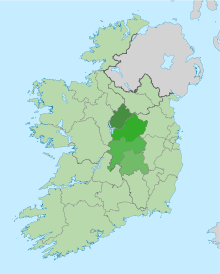Midlands Region, Ireland

The Midlands Region (coded IE012) is a NUTS Level III statistical region of Ireland. It consists of the territory of the counties of Laois, Longford, Offaly, and Westmeath. The Midlands region spans 6,524 km2, 9.5% of the total area of the state and according to the 2016 census has a population of 292,301.
Prior to 2014, the region was governed by the Midlands Regional Assembly. Statutory instrument No. 573/2014 abolished that assembly.[1][2] Since that date, the association between Regional Assemblies and NUTS regions has ceased. The NUTS regions are used for statistical reporting to Eurostat, while the Regional Assemblies are responsible for planning at a local government level.
The Midlands Region is also a tourist destination due to its natural environment which includes lakes, waterways and canals, as well as a history, heritage and culture which dates from early Christian times.[3][3]
The Midlands Region is the poorest region in Ireland with incomes well below the national average (approximately only 60% of national income levels). This region receives substantial funding from the European Union which has been used to fund road projects such as the M6 and M7/M8 project and help in farmers and flooded communities.
Midland Regional Authority
The Midlands region was administered by the Midland Regional Authority, which consisted of 24 elected representatives including the region's representative on the EU Committee of the Regions. These representatives met once a month and were nominated from the four local government councils of the region:[3]
The Regional Authorities were dissolved in 2014 and were replaced by Regional Assemblies.[1]
Demography
According to the 2011 census, the region had a population of 282,410, which constitutes 15.8% of the national population. Its population density was 43.3 persons per km2. The population of the regional capital, Athlone, is over 20,000.[4]
The region has a growing dependency ratio which is stated as having implications on health care, the types of housing needed as well as care for the elderly.[3]
Economy
The most significant industry in the Midlands region is the peat industry, as well as wood processing. Its wood processing industry now accounts for over one-third of the total processed timber produced in Ireland. Other strong industries include medicine, healthcare, engineering and chemical. It also has some very successful food and drink producers.[3]
[5] According to Eurostat figures for 2012, the region has GDP of €5.765 bn and a GDP per capita of €20,100 the lowest in the Republic.
The workforce of the region in 2015 was 114,000, which equated to a 87.6% employment rate. [6]
In 2017 the largest employment sectors in the Midlands region were [7]:
- Wholesale & retail trade 16%
- Manufacturing industries 12%
- Health & social work 11%
- Education 9%
- Public administration & defence 8%
- Agriculture 8%
Major settlements
A list of the ten largest settlements in the Midlands region. County capitals are included and are shown in bold.
| Rank | Town | County | Population (2016 census)[8] |
|---|---|---|---|
| 1 | Portlaoise | Laois | 22,050 |
| 2 | Athlone | Westmeath | 21,349 |
| 3 | Mullingar | Westmeath | 20,928 |
| 4 | Tullamore | Offaly | 14,607 |
| 5 | Longford | Longford | 10,008 |
| 6 | Portarlington | Laois/Offaly | 8,368 |
| 7 | Edenderry | Offaly | 7,359 |
| 8 | Mountmellick | Laois | 4,777 |
| 9 | Birr | Offaly | 4,370 |
| 10 | Clara | Offaly | 3,336 |
References
- 1 2 http://www.irishstatutebook.ie/2014/en/si/0228.html
- ↑ Statutory Instrument 573/2014
- 1 2 3 4 5 Irish Region Office - Regions of Ireland: Midlands Region
- ↑ http://www.cso.ie/px/pxeirestat/Statire/SelectVarVal/saveselections.asp
- ↑ "Archived copy". Archived from the original on 2014-10-06. Retrieved 2014-10-06.
- ↑ http://www.regionalskills.ie/Regions/midlands/Action-Plan-for-Jobs-Midland-Region-2015-2017.pdf
- ↑ https://www.ibec.ie/IBEC/Press/PressPublicationsdoclib3.nsf/vPages/Newsroom%7Eibec-highlights-need-to-address-infrastructure-imbalance-15-02-2017/$file/Local+Economic+Indicators+2017.pdf
- ↑ http://www.cso.ie/en/releasesandpublications/ep/p-cp2tc/cp2pdm/pd/